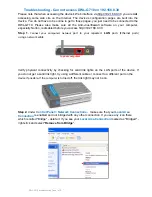
2.4.7.7
Network Registration
Before a modem can send or receive data it must register on a home or roaming
network. There are three different commands for checking network registration, each
designed for a specific cellular technology:
-
AT+CEREG
-
Used to check registration on Evolved Packet System (EPS) for 4G
(EUTRAN) networks .
-
AT+CGREG
-
Used to check GPRS (Packet Switched) registration for GPRS/EDGE
(2G/GERAN), and UMTS/HSPA/HSDPA (3G/UTRAN) networks.
-
Some LTE devices may reflect 4G network registration on this
command.
-
AT+CREG
-
Used to check GSM (Circuit Switched) network registration for 2G GSM
networks.
-
Some LTE devices may reflect 4G network registration on this
command.
Devices with 2G or 3G fallback should also be checking to see if the device has
registered on a 2G/3G network. In the event the modem is in an area with no LTE
coverage and it falls back to 2G or 3G it may show that its LTE registration (the
AT+CEREG response) was denied, not registered and searching, or not registered
and it has given up attempting, but its 2G or 3G registration was successful.
To check if a device has registered on a network issue the AT command from the
table below for the desired network technology, followed by the enter key:
<stat>
is the network registration status. The values of stat are available in the
modem's AT command manual and are also listed below for convenience.
PN 1002634 REV 1
© NimbeLink Corp. 2021. All rights reserved.
24
Access Technology
Command
Response
4G
AT+CEREG?
+CEREG: 0,<stat>
OK
3G/2G GPRS
AT+CGREG?
+CGREG: 0,<stat>
OK
2G GSM
AT+CREG?
+CREG: 0,<stat>
OK






































